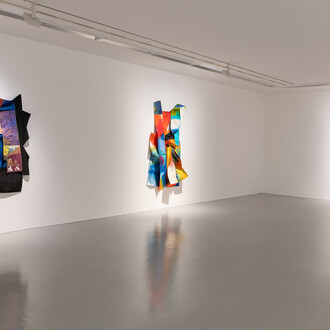The Irish Museum of Modern Art (IMMA) is proud to unveil Reverse migration, a poetic journey, the first solo exhibition in Ireland by internationally renowned artist, poet, and activist Cecilia Vicuña (b. 1948, Santiago de Chile). This major survey of Vicuña’s practice features numerous new paintings and new commissions. Emerging from Vicuña’s discovery of her ancestral ties to Ireland, the exhibition is a monumental meditation on survival and interconnectedness amid global ecological and political upheaval.
Vicuña’s multidisciplinary practice bridges visual art, poetry, sound, and performance. Born and raised in Santiago de Chile, Vicuña has been in exile since the early 1970s, following the 1973 military coup against Chilean president Salvador Allende; and her career is characterised by a drive to preserve and pay tribute to the indigenous history and culture of Chile. Reverse migration, a poetic journey is inspired by a visit to Ireland which she made in 2006 with her partner, poet James O’Hern, following Vicuña’s discovery of her genetic ties to the country, during which they honoured various archaeological sites with rituals of gratitude. This ancestral connection to Ireland is a narrative thread within the exhibition, which intertwines personal memory with indigenous traditions and a dialogue with Irish heritage.
Works on display span the breadth of Vicuña’s career, with an early section of the exhibition, curated by Miguel Lopez, featuring documentation of her early activism, performance and film works.
The exhibition includes significant examples of Vicuña’s precarios and quipus, two ongoing bodies of work since the 1960s, which have their origins in ancient Andean traditions. Central to the exhibition at IMMA is a site-specific quipu Aran Quipu - an ancient Andean system of record-keeping using knotted cords. Created with the participation of local makers, and made using Irish wool, the commission is a reference to the design of Aran sweater — thought to be symbolic of nature and the sea, as well as of the lives of Irish fishermen and Aran Islanders, for Vicuna the piece is a meditation on rising sea levels and the relationship of weaving and the sea. The work transforms the motif of the ancient quipu into a vessel for contemporary ecological and political discourse, suggesting the urgent need for collective action in the face of climate crisis.
Vicuña’s early canvases reflect an intuitive engagement with shamanic rituals. Brujo meaning “shaman” and the “soft geometry” inherent in Andean visual languages. These compositions are infused with references to Nasca textiles, pre-Columbian iconography, fungi, and myths surrounding altered states of consciousness, linking the ancestral with the visionary in a continuum of cultural memory.
Sound and poetry are integral to Vicuña’s artistic language and, for this exhibition, the artist has created a new sound work that embodies the oral traditions of indigenous cultures. Titled Mourning dialog, the piece joins in sequence a recording of a Keener – a professional mourner – from the Aran Islands, with one of Vicuna’s own a capella musical performances which mourns the death of the glaciers.
Vicuña explores sound as a binding thread between people and histories, mirroring the themes of interconnection and fragility found throughout her practice; and her soundscapes resonate with her visual works, blending spoken word, chanting and natural sounds into immersive experiences that traverse cultural and temporal boundaries. In the context of this exhibition, Vicuña’s improvisatory performances transform poetry into a participatory act, echoing the fluid and non-linear structure of her quipus.
Vicuña’s precarious poetic practice is inseparable from her visual and sonic explorations. Her fragmented, metaphor-rich verses reflect themes of displacement, environmental destruction, and cultural survival. Her poetry, like her quipus, invites an active engagement, weaving a narrative that is as evocative as it is open-ended.
A new poetry book titled Mapping the silence, by Vicuña and James O’Hern, is published in collaboration with Distance No Object, edited by Luke Roberts and Amy Tobin. The book explores their connections to Ireland and includes photos of their visits to Irish archaeological sites and of Vicuña’s offerings to Queen Maeve’s Cairn in Co. Sligo - one of the largest unexcavated neolithic monuments in Europe. The poems reflect on Vicuña and O’Hern’s time in Ireland in the 2000s as well as a more recent site visit, during which Vicuña visited the National Museum of Ireland to view its collection of Sheela-na-Gigs: medieval carvings of naked females posed in a manner which display and emphasise the genitalia.
The exposed genitalia of Sheela‑na‑Gigs can be read as creative empowerment or birth symbolism; similarly to many indigenous Andean traditions which feature a strong emphasis on the female body as central to life, regeneration and agriculture. A series of new Sheela-na-Gig paintings included in the exhibition highlight Vicuña’s desire to explore the connections between ancient imagery in both South America and Ireland. An original Sheela-na-Gig carving, on loan from the National Museum of Ireland, is also on display.
Elsewhere in the exhibition a bronze and ruby sculpture by Leonora Carrington, Vulture (Dragon), 2010, held in IMMA’s collection, demonstrates the influence of Carrington – her surrealist work as well as her interest in mythology, feminism and Mesoamerican traditions – during Vicuna’s early years as an artist she spent some time with Carrington. This influence is evident in paintings such as Obstructing the doors is dangerous (2023) and Medusa (1972/2023) – one of several paintings that Vicuña remade after the originals were lost in Chile due to the coup and her exile.
Through her innovative synthesis of visual art, sound, and poetry, Vicuña offers a deeply moving reflection on the interwoven histories of humanity and nature. Reverse migration, a poetic journey challenges us to listen to silenced voices, honour ancient wisdom, and reimagine our relationship with the earth in a time of urgent transformation.
















